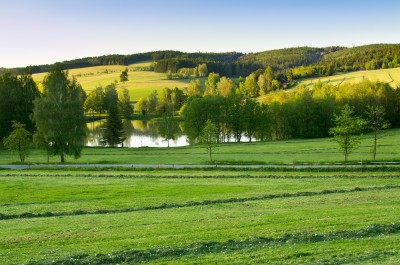The Rise of Organic Farming
Americans are spending more on organic food every year, and the trend shows no signs of slowing. The Organic Farming Research Foundation (OFRF) started a program in 1994 to track the success of the organic farm. At the time, there were less than 3,000 organic farms. Today there are 10,000 organic farms, producing about 2% of American food. During the 1990s, our spending on organic food rose around 25% annually, and the Hartman Group reports that 90% of Americans buy organic or are considering buying organic.
 So What Makes Food Organic, Anyway?
So What Makes Food Organic, Anyway?
Organic farming is comprehensive and ecologically balanced, utilizing principles such as crop rotation, natural pest control, and soil preservation.
Contrary to popular belief, organic food is not necessarily free of pesticides. It is simply grown without the use of synthetically produced pesticides. Many organic farmers do use pesticides that are derived from natural sources, but there are a variety of alternative methods available in organic farming.
Preserving the Soil: The Heart of Organic Farming
If a farm is a living entity, the soil is the lifeblood. Protecting and preserving the soil is at the center of most organic farming practices, and one of the biggest reasons that purchasing organic is so environmentally friendly.
Composting – Compost can come from a variety of sources, like food scraps, yard trimmings, and manure. Compost encourages beneficial bacteria, creating rich soil and lessening the need for synthetic fertilizers.
Cover Crops – Many organic farmers use cover crops in conjunction with their main crop. A cover crop protects soil from erosion, wind, weeds, and pests. They also attract insects like ladybugs which benefit the main crop.
Crop Rotation and Resting – The Israelites were commanded to let their farms lie fallow every 7 years, and it turns out there’s a good reason. Crop rotation and letting fields rest is one important way to create soil fertility. Growing the same crop on the same soil year after year leads to depletion of nutrients in the soil, so many organic farms will grow a crop like wheat one year, graze sheep on it the following year, grow a different crop the 3rd year, and so forth.
The Extra Cost
It’s absolutely true that most organic food costs more money than conventionally grown food. That’s because organic farming costs the farmer more money, too. It takes three years to transition from conventional to organic farming. Farmers must pay fees to be certified, along with extra inspections, documentation, and paperwork. Additionally, organic farming is usually much more more hands-on and labor-intensive, requiring more time and effort for farmer workers. Sure, you can buy food cheaper. But how will you end up paying for it?
There are standards that all organic farms must adhere to, but every one of them will be unique. Organic farming can be defined by certain criteria, but if you really want to know the nitty-gritty details about where your food comes from, I encourage you to get in touch with local farmers. Ask them what methods they use for pest control. Request a tour. Inquire about their soil preservation philosophy. Most organic farmers would be more than happy to educate you.
Why do you buy organic?
